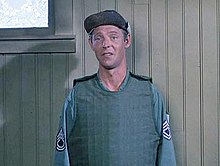Hogan's Heroes
Hogan's Heroes is an American television sitcom created by Bernard Fein and Albert S. Ruddy which is set in a prisoner-of-war (POW) camp in Nazi Germany during World War II, and centers around a group of Allied prisoners who use the POW camp as an operations base for sabotage and espionage purposes directed against Nazi Germany.
Bob Crane starred as Colonel Robert E. Hogan, coordinating an international crew of Allied prisoners covertly running a special operations group from the camp.
The plot occurs during the permanent winter season in the fictionalized Stalag 13 just outside Hammelburg in Nazi Germany, though details in the show are inconsistent with the real-life camp and city's location in Franconia.
According to subsequent storylines, when the group was formed under Hogan's command, he (and they) received the following orders: "You will assist escaping prisoners, cooperate with all friendly forces, and use every means to harass and injure the enemy."
The prisoners cooperate with resistance groups (collectively called "the Underground"), defectors, spies, counterspies, and disloyal German officers to accomplish this.
Under Hogan's leadership, the prisoners also devise schemes such as having Sergeant Carter visit the camp disguised as Adolf Hitler as a distraction, or rescuing a French Underground agent from Gestapo headquarters in Paris.
To the bafflement of his German colleagues who know him as an incompetent sycophant, Klink technically has a perfect operational record as camp commandant as no prisoners have successfully escaped during his tenure.
Hogan and his men assist in maintaining this record so they can continue with their covert operations without active interference from the German military.
Considering Klink's record, and the fact that the Allies would never bomb a POW camp, Stalag 13 appears to be a very secure location.
By the fourth season, the set designers found a more permanent solution and lower cost, using white paint to give the illusion of snow.
After the series ended in 1971, the Stalag 13 set remained standing until 1974 when it was destroyed while filming the final scenes of Ilsa, She Wolf of the SS (1975).
Klink and Schultz's characters were given broad Saxon and Bavarian dialects, playing on regional stereotypes to underline the notion that they are comic figures.
[20] Donald Bevan and Edmund Trzcinski, the writers of the 1951 play Stalag 17, a World War II prisoner-of-war story turned into a 1953 comedy/drama feature film by Paramount Pictures, sued Bing Crosby Productions, the show’s producer, for infringement.
[21] In 2013, Fein (through his estate) and Ruddy acquired the sequel and other separate rights to Hogan’s Heroes from Mark Cuban via arbitration, and a movie based on the show was planned.
An additional one-page parody called "Hochman's Heroes" took the show's premise to the next level by setting it in Buchenwald concentration camp.
[33] In 1968, Clary, Dawson, Dixon, and Hovis recorded an album titled Hogan's Heroes Sing the Best of World War II, which included lyrics for the theme song.
[34] While the show was in production, Crane, Klemperer, Askin, and Banner all appeared (as different characters) in the 1968 film The Wicked Dreams of Paula Schultz.



